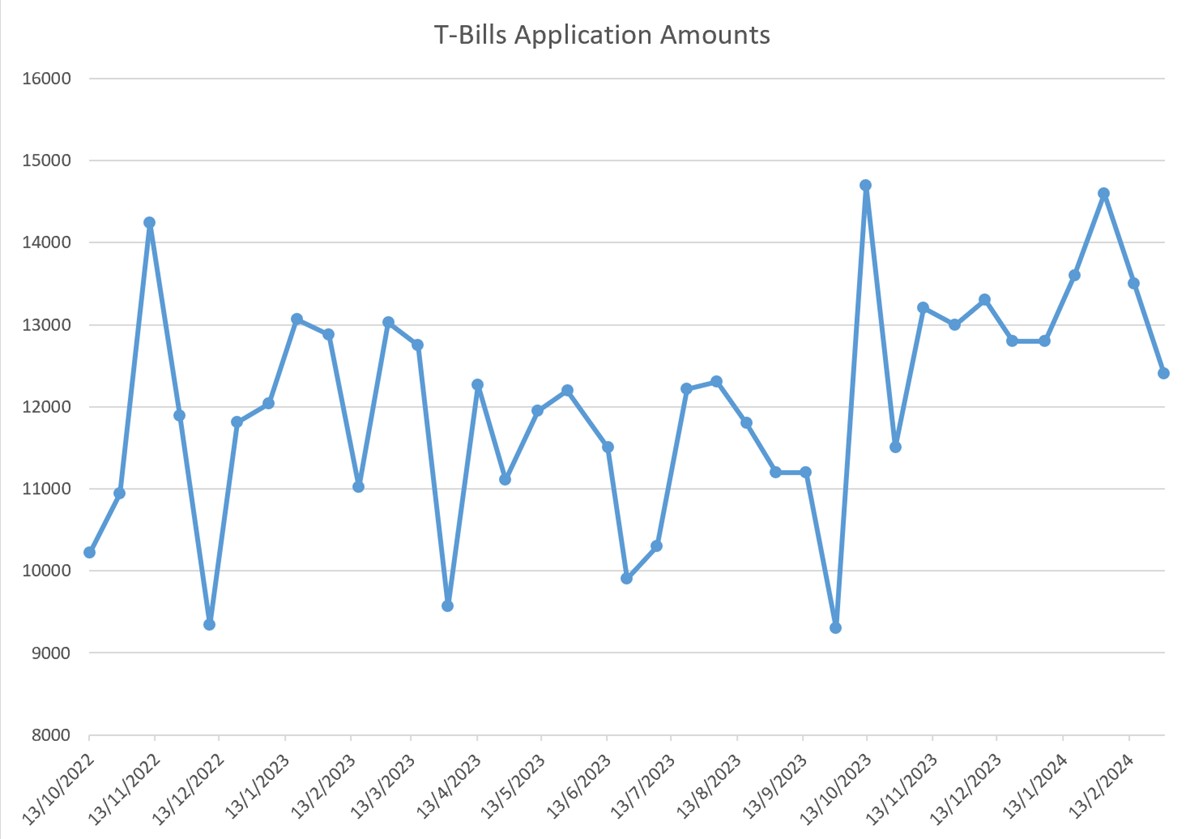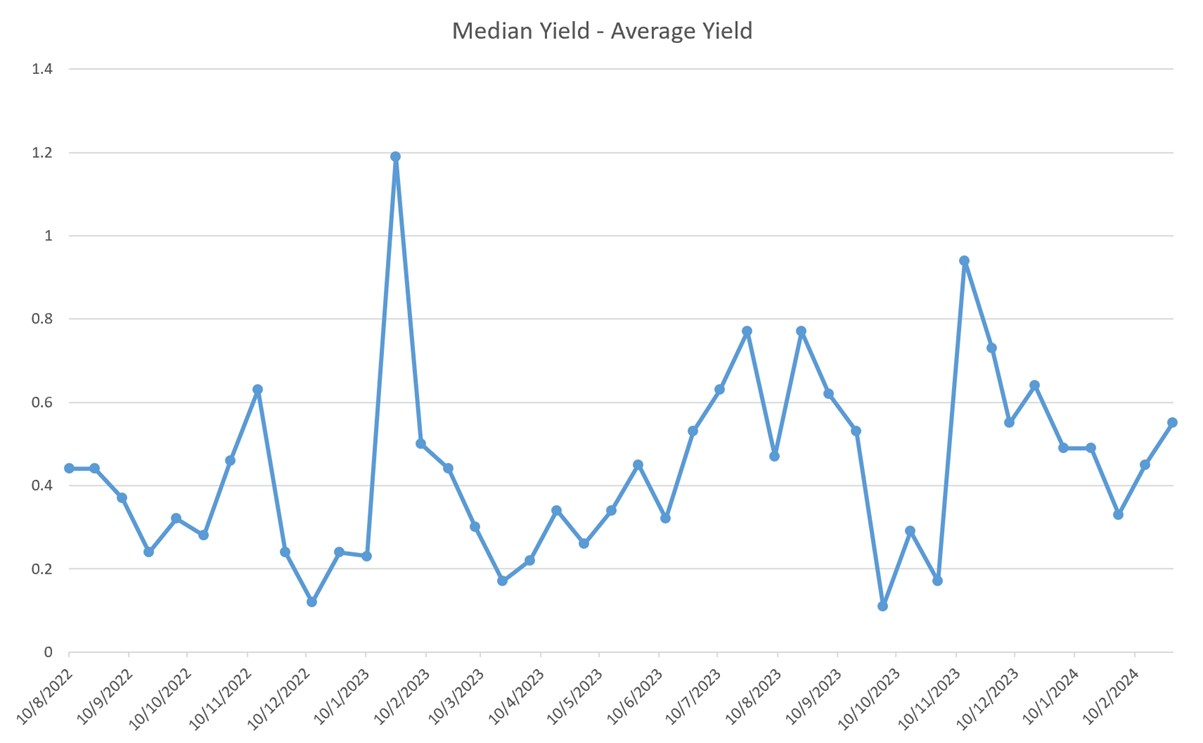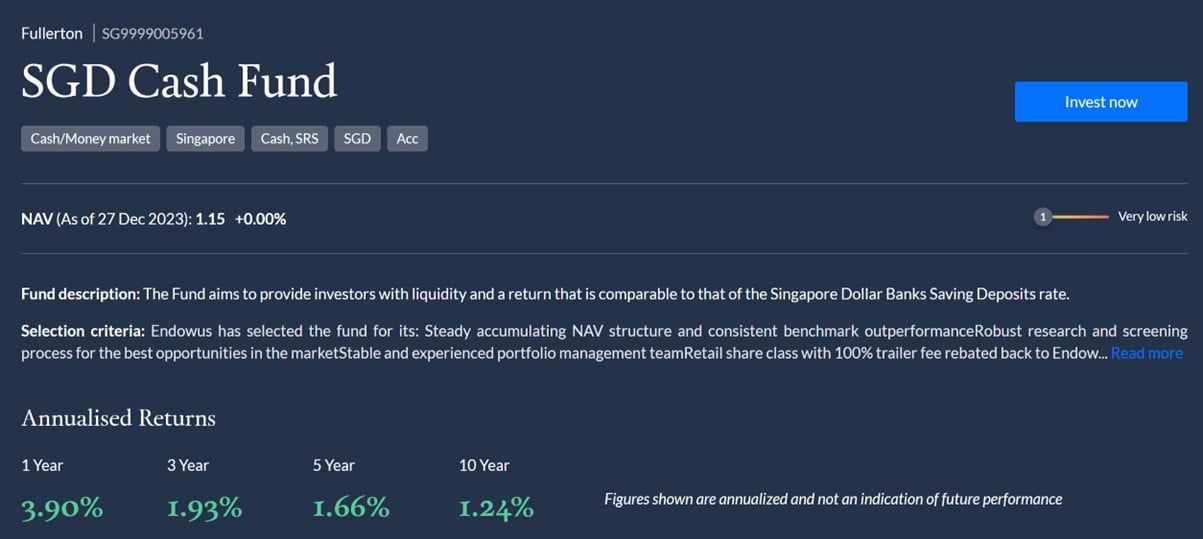So the next 6-month T-Bills auction is on 14 Feb.
After closing as high as 4.07% only a few months ago.
T-Bills yields have since plunged to 3.54%.
In the most recent auction however, T-Bills recovered to 3.80%.
At 3.80%, 6-month T-Bills offer a much higher yield than Fixed Deposits (3.35%).
So I wanted to discuss a couple of questions:
- What is the estimated yield on the next 6-month T-Bills auction?
- Are money market funds or fixed deposits still a better buy than T-Bills?
- Where to park cash today?

Next T-Bills auction is on 14 Mar (Thursday) – (BS24105X 6-Month T-bill)
First off – next 6 months T-Bills auction is on 14 March (Thurs).
This means that:
- If you’re applying in cash do apply by 9pm on 13 March (Wed)
- If you’re applying using CPF-OA do apply by 12 March (Tue)

What is the estimated yield on the next 6-month T-Bills auction? (BS24105X 6-Month T-bill)
I’ll split the analysis up into 2 parts:
- Fundamentals perspective (economic growth, inflation, global interest rates etc)
- Technical perspective (supply-demand)
(1) Fundamentals perspective for T-Bills:
T-Bills trade at 3.78% on the open market
6-month T-Bills are trading at 3.78% on the open market.

But… T-Bill trading liquidity is incredibly thin
But we’ve seen the past few auctions that trading liquidity on the T-Bills is so thin (just look at trading liquidity in the chart above) – that actually the market pricing is not that indicative.
You’ll find that the market pricing actually takes its cue from the latest T-Bills auction.
The past few auctions where the T-Bills auction yield diverged materially from market price (whether up or down).
It was actually market price that adjusted to the latest T-Bills auction yield, rather than the other way around.
So I would caution against placing too much reliance on market pricing on T-Bills – there just isn’t sufficient trading liquidity for true price discovery.
12-week MAS Bills flat at 3.93%
The institutional only 12-week MAS Bills have been flat at 3.93%.
Sharp moves in MAS Bills are a good indicator of the trend for T-Bills.
So as of now, MAS Bills are pointing towards flattish yields.
If you are submitting a competitive bid I do suggest taking a quick look at the latest MAS Bills pricing before you apply.
If there is a sharp move up or down – that could suggest a similar trend for T-Bills (can access it here).

Expectations for interest rate cuts in 2024
The market is overwhelmingly pricing in interest rate cuts in 2024.
The market today is pricing in 4 interest rate cuts in 2024 – a total of 1.00% in rate cuts:

That being said, it was just a month or two ago that the market was pricing in a March rate cut, and 6 interest rate cuts in 2024.
After the strong inflation data and comments from Powell, the market has pared back those expectations significantly.
So this might actually be bullish for interest rates (in the sense of higher rates) – which is what we’ve seen the last 2 auctions.
That said Powell this week did seem to confirm interest rate cuts in 2024, although it did not drive any noticeable impact in US short term yields.
From a Technicals, supply-demand perspective for T-Bills
From a more micro perspective, what matters is the supply-demand dynamics.
T-Bills Supply is going down to $6.3 billion (vs $6.4 billion previous auction)
Unfortunately – the amount of T-Bills on auction is going down again.
$6.3 billion of T-Bills vs $6.4 billion of T-Bills the previous auction.
T-Bills supply seems to be a pretty decent predictor of yields so far, so this is not a good sign and points towards lower yields.
That said you can see how the auction amount at >$6 billion is much higher than in 2023, which was in the $5 billion range.

Demand for T-Bills dropped to $12.4 billion (vs $13.5 billion the previous auction)
The good news though, is that demand for T-Bills went down in the most recent auction.
Only $12.4 billion in applications, down 8.1% from the previous auction ($13.5 billion).
That said, while demand has come down, it still remains on the high side relative to demand in 2023:

Will demand bounce back now that T-Bills yields are back at 3.80%?
The big question is whether you’ll see demand bounce back.
Now that T-Bills are back at 3.80%, I think that’s pretty attractive – to the point where I myself might apply for T-Bills again.
The fear is that many other investors may think the same way, leading to a drop in T-Bills yields.
Well on this your guess is as good as mind.
But it’s a risk worth bearing in mind – a risk that a competitive bid can help guard against.
T-Bills yields up to 3.80% (vs 3.66% the previous auction)
Because of the lower demand, we saw T-Bills yields rebound to 3.80% the previous auction.
This is up very nicely from 3.66% the auction before.
At 3.80%, we’re back in the range of T-Bills yields we saw in 2023.
So much for interest rate cuts:

Median Yield – Average Yield spread went up – more “lowballers”?
To illustrate what this is:
Imagine you have 100 bids.
The median yield, is if you arrange all the bids from small to high, and take the yield of the 50th bid.
While average yield, is adding up the yields of all 100 bids and dividing by 100.
So average yields are skewed by lowball bids, while median yields are not.
To put it simply – the bigger the spread between the median yield and average yield, the more “low-ballers”.
In the latest auction – spreads have actually started to go up again.
The fact that cut-off yields went up despite this, suggests the lower demand had a big role to play in the higher yields.

Estimated yield of 3.70% – 3.85% on the 6-month T-Bills auction? (BS24105X 6-Month T-bill)
Let’s put it all together.
Market is pricing in 4 interest rate cuts in 2024.
SGD interest rates have been flat the past week or so, with 6-month T-Bills yields at 3.78% on the open market.
Meanwhile demand for T-Bills has come down quite a bit from record highs (although it remains high relative to 2023 levels).
However, there is a fear that T-Bills demand may bounce back due to the recovery in yields.
While the supply of T-Bills is going down slightly this auction to $6.3 billion.
Given all of the above – I think there is a risk T-Bills yields may come in lower than the levels hit the previous auction (3.80%).
All things considered I would probably go with an estimated yield of 3.70% – 3.85% on the next T-Bills auction.
Do note that this is just an estimate, and actual yields can vary if demand is very high, or bidding is funky.
Should you submit a competitive or non-competitive bid?
I usually encourage investors to submit a competitive bid (just in case there is a freak result and yields drop a lot).
And submit as close to the deadline as you can, so you can take a look at where market pricing is at that time before deciding on your bid.
But I know some investors really don’t like competitive bidding.
In which case non-competitive bidding is probably fine as well.
But do note that with non-competitive, if there is a freak result and yields drop to 3.0%, you are still forced to buy.
Which is a better buy – T-Bills vs Money Market Funds, Singapore Savings Bonds or Fixed Deposit or Savings Accounts?
BTW – we share commentary on Singapore Investments every week, so do join our Telegram Channel (or Telegram Group), Facebook and Instagram to stay up to date!
I also share thoughts on Twitter regularly.
Don’t forget to sign up for our free weekly newsletter too – with weekly roundups every Sunday!
Money Market Funds pay about 3.8% – 4.1% yield
Mari Invest, which is the money market fund solution via Mari Bank in a tie up with Lion Global, pays about 3.9% – 4.1% (exact yield fluctuates over time).
Likewise Fullerton SGD Cash Fund pays about 3.6% – 3.9%.

Money Market Funds are technically not risk free though – so this is a big point to note.
I’ve extracted the asset allocation for Mari Invest below (exact fund is Lion-MariBank SavePlus).
Almost 70%+ of the assets are parked in MAS Bills backed by the Singapore government, so risk should be on the lower side.
However just like all money market funds, this is technically not risk free, and in extreme situations there is a possibility of capital loss.

The benefit though, is that you can get your money back with T+1 liquidity, which is a big plus vs T-Bills
I personally have started putting some cash of late into Money Market Funds instead of T-Bills of late, due to the liquidity benefits.
However now that T-Bills yields are back up I might move some of the cash back into T-Bills.
Singapore Savings Bonds are a pretty decent buy for those who missed the boat previously
Yields on the latest Singapore Savings bonds are:
- 2.95% for the first 6 years
- 3.04% for 10 years
That’s actually pretty attractive, given that you can lock in for 10 years.
For those who missed the board with Singapore Savings Bonds a few months back at >3.0% yields, this is your chance.
Note that each person can apply for up to $200,000 Singapore Savings Bonds.

Best Fixed Deposit option? 3.35% with CIMB
The Best Fixed Deposit option I found is 3.35% (3.40% for preferred banking) with CIMB.
Minimum of $10,000 deposit.
So if you don’t want to buy T-Bills, but want something risk free (below SDIC limit), this is probably the next best thing.
Yields are much, much lower vs the latest T-Bills though, so I don’t think fixed deposit is that attractive any more.

What to ask yourself – split cash between T-Bills, Fixed Deposit and Savings Accounts?
A lot of you have asked what to consider when deciding how much cash to split between each of the following options:
- T-Bills
- Fixed Deposits
- Money Market Funds
- High Yield Savings Accounts
The way I see it, it’s broadly a 2 step process:
- How much liquid cash do you need?
- Rest goes into highest yield options – based on your comfort level on risk
Key question to ask – how much liquid cash do you need?
I would say the key question to ask is how much liquid cash you need, to meet your spending needs the next 6 months.
Think about how much you need to spend.
Then think about how much cash you are expecting to come in over the next 6 months.
The difference is the amount of liquid cash you would need.
So if all of your spending needs are going to be met by your salary, or if a big bonus is coming in – then you can actually run very little liquid cash.
Whereas if you’re going to buy a house, a new car, or a big renovation, you’ll need to plan ahead and have that amount of cash set aside in liquid cash.
Some guidelines on liquidity – better safe than sorry
As a general note I would say don’t be stingy with liquidity.
It’s one of those where it’s better to be safe than sorry.
So after you run the analysis above – you’ll want to buffer for unexpected scenarios too.
For example a big medical bill that you need to pay upfront, then claim from insurance after.
A big car repair bill.
A decline in stocks that leads you to want to buy some stocks / REITs.
A loss of job, meaning no income in the short term.
Things like that.
As a general note I would say you always want to have enough liquid cash on hand to cover 6 months worth of expenses, as a worst case scenario.
Liquid Cash should go into options accessible on short notice – savings accounts, fixed deposits, money market funds
Once you have the number above.
That amount of liquid cash, should go into options that you can get back with ideally a day or two’s notice.
That will include:
- High yield savings accounts (eg. UOB One, OCBC 360) – as a savings account you can withdraw any time
- Fixed Deposits – can break anytime by telling the bank, although you will lose accrued interest
- Money Market Funds – they are T+1 liquidity
Number (1) tends to have the highest interest rates, with accounts like UOB One paying a 5.0% effective interest rate on $100,000.
So that should be the priority – and you shouldn’t move on to fixed deposits or money market funds until you’ve maxxed out this option.

Singapore Savings Bonds is an outlier, because technically the money only comes back at the start of the next month.
In a worst case scenario if you just missed the redemption window, you might need to wait a whole month to get the money back:

I would say some Singapore Savings Bonds is fine as you can get the money back reasonably quickly, but don’t overdo it and put 90% of your liquid cash into Singapore Savings Bonds.
Rest of the cash goes into highest yield options – based on your comfort level on risk
Once you have the above – the rest just goes into the highest yielding option.
As of today, that’s probably Money Market Funds like MariInvest or Fullerton SGD Cash Fund.
But Money Market Funds are technically not risk free, so I know not everyone is comfortable putting their entire nest egg into something that is not zero risk.
In which case you can consider T-Bills or fixed deposits.
Picking between T-Bills vs Money Market Funds vs Singapore Savings Bonds vs Fixed Deposit vs Savings Accounts?
I would say if you want the highest short term yield, T-Bills / Money Market Funds are probably your best bet today.
The benefit of T-Bills is that it’s risk free, and you lock in the rates for 6 months, but at the cost of liquidity.
The benefit of Money Market Funds is that you can get the money back anytime with T+1 liquidity, but it’s technically not risk free, and the rates fluctuate over time.
Where am I parking my cash for liquidity?
Personally, I’ve been parking my cash in a mix of the following for liquidity:
|
Instrument |
Approx Yield |
Maximum |
|
UOB One |
5% |
$100,000 |
|
Singapore Savings Bonds |
3%+ (based on prior yields) |
$200,000 |
|
MariBank Account |
2.88% |
$75,000 |
|
Mari Invest (or Fullerton SGD Cash Fund) |
3.9% – 4.1% |
No maximum (not risk free) |
Maribank pays 2.88% on up to $75,000, SDIC insured
The Maribank Savings Account pays 2.88% on up to $75,000, with no minimum amount, no hoops to jump through, and SDIC insured.
Pretty much a no brainer if you have spare cash and want to generate a higher yield without any lockup or any requirements to fulfil.
Promo Code for FH Readers (extra $10 Shopee Voucher)
Maribank very kindly reached out to offer an exclusive promo code for FH Readers
Sign up for a Mari Savings Account (using the promo code “MARI28FH”) and get a $10 Shopee voucher with no min spend.
Full disclosure that I don’t get any benefit from you guys using this code, so the benefit is all yours. ????
Promo ends 30 June 2024, Full T&Cs here.
This article was written on 8 March 2024 and will not be updated going forward.
For my latest up to date views on markets, my personal REIT and Stock Watchlist, and my personal portfolio positioning, do subscribe for FH Premium.
Buy Bitcoin, Ethereum, and crypto on Coinhako – 10% off trading fees
I use Coinhako to purchase Bitcoin, Ethereum and crypto.
Enjoy 10% off trading fees using:
Invitation Code: CwHdSgU
Or sign up link: https://www.coinhako.com/affiliations/sign_up/CwHdSgU
Check out my full review on how to buy Bitcoin / Ethereum.
WeBull Account – Get up to USD 2500 worth of shares
I did a review on WeBull and I really like this brokerage – Cheap US Stock, Options and ETF trading, in a very easy to use platform.
I use it for my own trades in fact.
They’re running a promo now.
You can get up to USD 2500 free shares.
You just need to:
- Sign up for a WeBull Account here
- Fund USD 500
- Execute 5 trades

Trust Bank Account (Partnership between Standard Chartered and NTUC)
Sign up for a Trust Bank Account and get:
- $35 NTUC voucher
- 1.5% base interest on your first $75,000 (up to 2.5%)
- Whole bunch of freebies
Fully SDIC insured as well.
It’s worth it in my view, a lot of freebies for very little effort.
Full review here, or use Promo Code N0D61KGY when you sign up to get the vouchers!
Portfolio tracker to track your Singapore dividend stocks?
I use StocksCafe to track my portfolio and dividend stocks. Check out my full review on StocksCafe.
Low cost broker to buy US, China or Singapore stocks?
Get a free stock and commission free trading Webull.
Get a free stock and commission free trading with MooMoo.
Get a free stock and commission free trading with Tiger Brokers.
Special account opening bonus for Saxo Brokers too (drop email to [email protected] for full steps).
Or Interactive Brokers for competitive FX and commissions.
Hi FH,
Thanks for the useful article. May I pls know to buy a T-bill using SRS, what is the deadline?
Hi Lionel, it will be the same as cash – 9pm the day before.